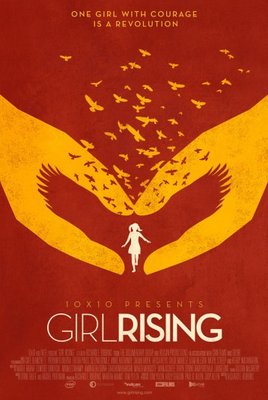 |
| Girl Rising (2013) |
This is a guest post written by Colleen Lutz Clemens.
Girl Rising unites prominent female authors, such as Edwidge Danticat from Haiti or Aminatta Forna from Sierra Leone, with girls such as Wadley or Mariama from their respective countries. Together, Danticat and Wadley, Forna and Mariama, and seven other pairs have their stories of oppression, resistance, community, and family narrated by the likes of Beyoncé or Meryl Streep. Each story works as a discrete unit in the film, using animation, music, and images to give the viewer a glimpse into each girl’s reserve of resilience.
 |
| Wadley from Haiti |
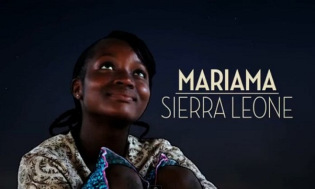 |
| Mariama from Sierra Leone |
Connecting the nine stories are interludes which show other girls in school uniforms as they hold us up signs sharing dreary statistics about girls in the developing world, such as boys outnumber girls in primary schools by 33 million. The stories teach the audience that these girls live in families that love them—even if that love looks different than it does in “the West”—and that education, poetry, art, and organizing are the keys to giving each girl the tools to recognize her own importance and to find her voice.
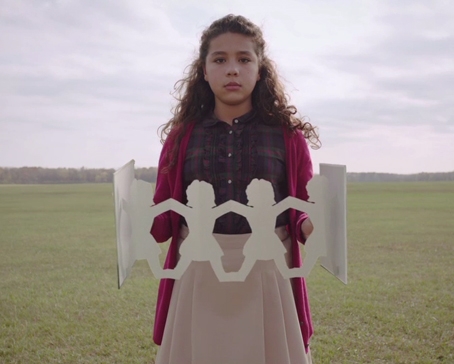 |
| One of the interludes. |
Girl Rising knows and plays to its audience: women in “the West” with access to basic services and education who have some extra money in the bank and a desire to help other women. The documentary works to connect audience members to a movement with the lofty goal of raising money to ensure more girls are educated worldwide.
I love the idea of educating girls. LOVE IT. I love any movie that takes the time and attention to tell the stories of girls to an audience that otherwise would not hear such narratives. I want every girl who wants (and maybe even doesn’t want) to be sitting on the floor or on a chair wearing a hijab, burqa, or baseball cap in a classroom to be there. If that movie is working toward that goal, then I am just about all in, which as a scholar and critic is pretty much as “in” as I can get. However, what proves potentially problematic is the way in which narrator Liam Neeson offers the convenient promise that once girls are educated throughout the world, then global issues will diminish and all will be right.
Thus, two things are still bothering me after seeing the movie a few weeks ago. First, fixing the world via education seems like a pretty big burden to put on the shoulders of girls. The implication of the film is that if girls would just have access to education, so many of the world’s problems such as poverty and malnutrition would disappear. To me this rings the same bell as when people say, “If only women ran the world, there would be no more wars.” There would be wars. There isn’t some kind of natural peace sense linked to the X chromosome. I want girls and women to have the agency that women around the world have been working for—I believe in that idea and in the movie’s thesis that if girls have education, the world can be better. But I don’t think it is just or fair to expect girls to fix all of the problems the movie seems to think they should fix.
Second, the film exploits the burqa to make its point about women’s suffering. It should be no surprise that the last segment is the one that Western audiences will be most eager to witness: the story of Amina in Afghanistan. This young girl is forced to marry at an age when an American girl would still be hanging One Direction posters on her pink walls. Watching her story takes the viewer’s breath away. The girl seemingly has no agency, no voice, until Western filmmakers come and listen to her. She lives in fear of violence, of becoming shamed by expressing her desire to live a life different from the one prescribed to her by virtue of her gender. She is the image of the Aghani woman Westerners are so familiar with but know little about.
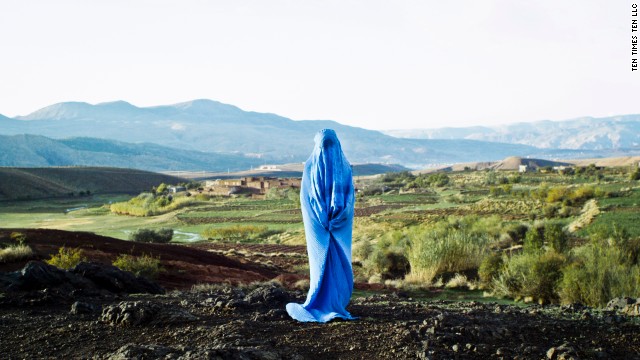 |
| Amina |
Here’s my concern: I don’t think any of these problems will go away if she rejects and sheds her burqa. So when (spoiler alert) veiled girls start to run up the hill tearing off their burqas as the music crescendos and the voiceover offers us the idea that liberation is just around the corner once the girls reveal their identities, I cringe. This gesture is a bravery manufactured for the audience. Taking off a burqa is a solution that makes the audience feel good. It echoes the rhetoric of post-9/11 warmongering when suddenly we needed to invade countries in the name of women who needed liberation, a convenient excuse when those same women’s plights were completely ignored up until September 10, 2001. Of course, the movie does this on purpose, allowing us to feel justified all over again in our simultaneous invasion and ignorance.
I admire the girls. I want Amina to have everything she wants, even after only meeting her for ten minutes in the film. Yet I fear the other girls’ stories get lost in the noise of the past decade’s war with countries where “brown, veiled” people live. I was thrilled to be invited to co-lead a discussion after the film, yet the moment the lights went up the audience only wanted to talk about Afghanistan, about the Taliban, about Islam. Ten minutes into the discussion I gently steered the conversation back to the girls, as they had already been forgotten in the audience’s desire, and I might say selfish desire, to forget the bigger issue and make the suffering and anxiety all about ourselves again.
But Amina’s section also contains my favorite part of the film: when she looks at the camera and accuses the audience of being silent. She pointedly asks: what are “you” going to do? Of course, right after this segment, the film gently supplies an answer: text GIVE to 5515 and donate money to the 10×10 organization. I didn’t see a flood of phones light up in the theater. But this move of Amina looking at an audience filled with Americans and calling them out for staying silent in regards to her actual issue—“I have no school to go to, my family married me off at 13”—gives me the greatest of hope. Not her running up a hill taking off a burqa that she probably put right back on when she got to the other side of the hill: I can only imagine that she was forced to put her veil back on, although the film’s website says it cannot offer information about her current status as it may endanger her. But that she would look the West in the eye and say “You cannot forget about me. I will not forget about you. We are in this together”: that kind of girl rising is the kind of movement I want to be a part of, one what works toward greater access to education and doesn’t need to make me temporarily feel good or justified in the process.
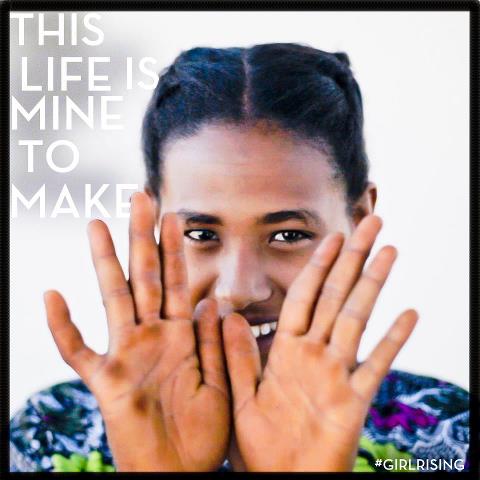 |
| Azmera |
Colleen Lutz Clemens is assistant professor of non-Western literatures at Kutztown University. She blogs about gender issues and postcolonial theory and literature at http://kupoco.wordpress.com/. When she isn’t reading, writing, or grading, she is wrangling her one-year old daughter, two dogs, and on occasion her partner.






